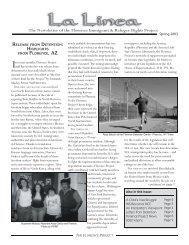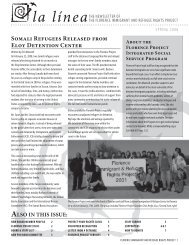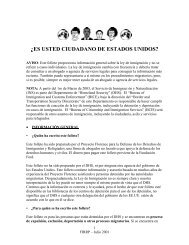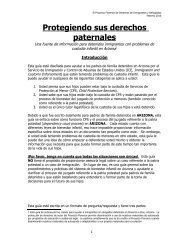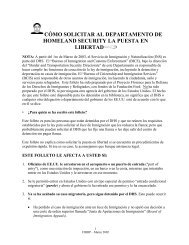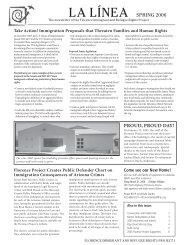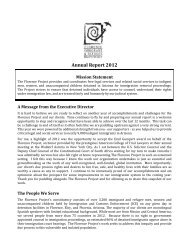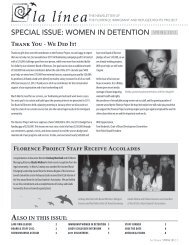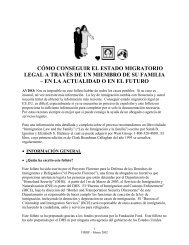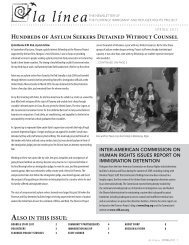HOW TO APPLY FOR ASYLUM - The Florence Project
HOW TO APPLY FOR ASYLUM - The Florence Project
HOW TO APPLY FOR ASYLUM - The Florence Project
Create successful ePaper yourself
Turn your PDF publications into a flip-book with our unique Google optimized e-Paper software.
for removal or voluntary departure and then come back to the United States<br />
It is very difficult to be locked up for a long time, and it is normal to feel frustrated, sad, and depressed. A<br />
lot of people feel bad because they cannot work and provide for their families, or they feel like they are<br />
wasting their time. If you cannot pay your bond, you may be thinking about giving up your rights and<br />
accepting an order of removal from the United States, so that you will not have to spend any more time in<br />
detention.<br />
If you are not afraid to return to your country, or if, after reading this booklet, you decide that you do not<br />
qualify for asylum or withholding, and if you do not qualify for some other type of defense, accepting removal<br />
or applying for “voluntary departure” might be the right thing to do.<br />
But if you are afraid to go back, giving up now may be a big mistake. First, you should<br />
think about your life and the danger you will face if you return.<br />
Second, if you are thinking about coming back to the United States in the future, accepting removal or<br />
voluntary departure may be a mistake. If you return to the United States illegally after an order of removal or<br />
voluntary departure, you will not have a work permit and you will always run the risk of being caught by DHS.<br />
If you are caught, you can be charged with the crime of returning illegally after an order of removal. This is a<br />
felony for which you can be put in prison. If you have a criminal history, in some cases, the law says you can<br />
go to prison for up to 20 years for coming back to the U.S. illegally!<br />
Also, if you are caught returning to the United States and you then apply for asylum, the judge may decide<br />
that, because you did not apply for asylum or withholding the last time you were in the United States, you<br />
are not really afraid to return to your country.<br />
Finally, accepting removal or even getting something called “voluntary departure” may make it difficult or even<br />
impossible for you to return to the United States legally, even if you have family here legally or some other way<br />
to immigrate. If you return illegally to the United States after an order of removal, DHS can put you into a<br />
proceeding called “Reinstatement of Removal” where your previous removal order will be “reinstated.” This<br />
means that DHS will remove you again, and you may not have the right to see an Immigration Judge before you<br />
are removed unless you express a fear of return to your country and pass a reasonable fear interview.<br />
As you can see, there are many reasons why you should fight your case now if you have a case to fight. But if<br />
you are thinking about not applying to stay in the United States and you want to know more about how being<br />
removed from the United States can affect you in the future, you should read the booklet called, “How to<br />
Apply for Voluntary Departure.”<br />
• If I apply for asylum or withholding of removal, will I be putting my family members in my<br />
country in danger<br />
Some people are afraid that the information on their asylum application can get back to their country and be<br />
used against family members who are still there. Unless you are well known in your country and you seek<br />
publicity about your case, this is not likely. A copy of your asylum and withholding of removal application does<br />
go to the U.S. Department of State, but the Department is not supposed to contact your government about you.<br />
<strong>The</strong>re are regulations that cover the confidentiality of asylum claims. You can also tell the Immigration Judge<br />
about your concerns and ask that the immigration hearing be closed to the public and that the information you<br />
Page 5 of 49<br />
FIRRP- last update June 2007



